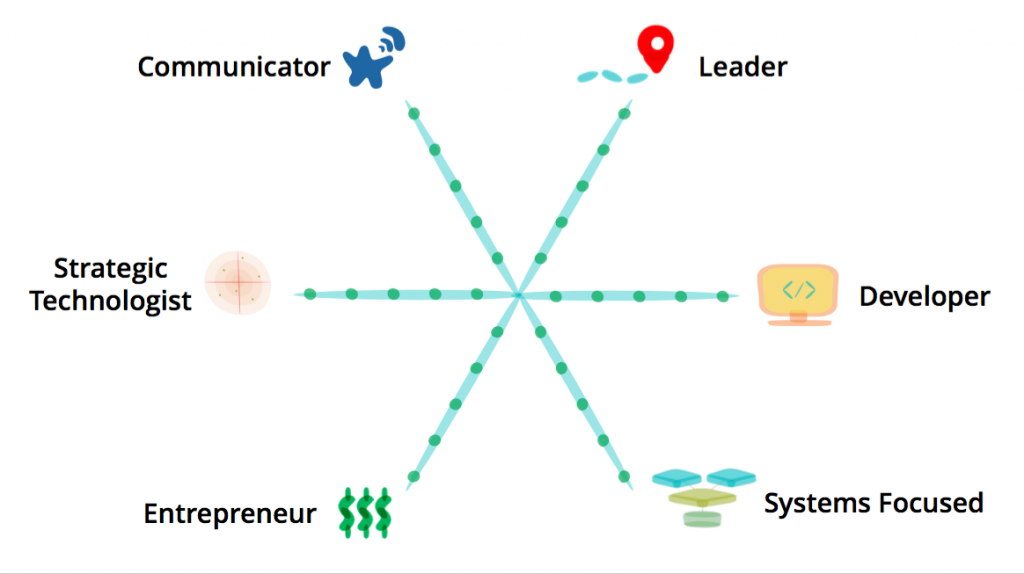The Well Rounded Architect
In this blog post, I explore the six different dimensions I covered in my recent talk at the O’Reilly Software Architecture conference in London called “The Well Rounded Architect.”
The elements of the well-rounded architect
- Acting as a Leader
- Being a developer
- Having a systems focus
- Thinking like an entrepreneur
- Balancing strategic with tactical thinking
- Communicating well
Acting as a Leader
Good software architects understand that their role as a leader is not necessarily telling developers what to do. Rather, good architects act like a guide, shepherding a team of developers towards the same technical vision drawing upon leadership skills such as story-telling, influencing, navigating conflict and building trust with individuals to turn their architectural vision into reality.
A good leader, and thus, a good architect, will listen carefully to the opinions of each contributor, fine-tuning their vision with feedback from the team. This leads well onto the next point.
Being a developer
Making good architectural choices is a function of balancing an ideal target architectural state with the current state of a software system. As an example, there is no sense in adding a document database to a system if the problem domain is better suited for a relational database, even if that’s boring. An architect may feel tempted to impose technologies or architectural choices without considering the fit for the problem space – AKA behaviours of the “ivory tower architect.”
The best way an architect can mitigate this is by spending time with developers and time in the code. Understanding how the system has been built up, and the constraints of the system as it stands today will give the architect more information about the right choices for today’s environment.
Having a systems focus
Seasoned developers know that code is only one aspect to working software. To make code run, a seasoned developer understands there are other important quality attributes necessary for code to run well in its production environment. They consider aspects like deployment processes, automated testing, performance, security, and supportability. Where developers may approach these quality attributes ad hoc, an architect will focus on understanding not just the code but also the quality attributes necessary to meet the many needs of different stakeholders such as support, security, and operations staff.
The good architect focuses on finding solutions that can satisfy as many of these different stakeholder needs instead of choosing a tool or approach optimised for the preferences or style of a single contributor.
Thinking like an entrepreneur
All technology choices have costs and benefits, and a good architect will consider new technology choices from both perspectives. Successful entrepreneurs are willing to take risks, but seek ways to learn quickly and fail fast. Architects can approach technology choices in a similar way, seeking real-world information about short- and long-term costs and the likely benefits they will realise.
A good example is when the architect avoids committing to a new tool based on reading a new article, or having heard about it at a conference. Instead they seek to understand how relevant the tool is in their environment by running an architectural spike to gather more information. They don’t pick a tool based on how good the sales pitch is, but what value it offers, given what they need for their system. They also look for the hidden costs of tools such as how well is a tool supported (e.g. level of documentation, community adoption), how much lock-in the tool brings or the extra risks it introduces over the long-term.
Balancing strategic with tactical thinking
A lot of teams build their software reactively with individual developers choosing tools and technologies that they are most comfortable with, or have the most experience with.
The good architect keeps an eye out for what newer technologies, tools or approaches might be useful but does not necessarily draw upon them immediately. Technology adoption requires a considered approach looking at a long-term horizon. Architects will seek for a good balance between agility (allowing the team to move fast) and alignment (keeping enough consistency) at both a team and organisational level.
An exercise like the Build your own Tech Radar is a useful tool to explore technologies with strategy in mind.
Communicating well
Architects know that effective communication is a key skill for building trust and influencing people outside of the team. They know that different groups of people use different vocabulary and that using the technical terms and descriptions with business people makes communication more difficult. Instead of talking about patterns, tools and programming concepts, the architect uses words their audience will be familiar with. Communicating technical choices to business people with words like risk, return, costs, and benefits will serve an architect better than the words they use with their development team.
An architect also realises that communicating within the team is just as important as outside, and will use diagrams and group discussions to establish and refine the technical vision, and use a written log like an Architectural Decision Log or a wiki to provide a historical trail for future generations.
Conclusion
Doing the job of a well-rounded architect is not easy. There are so many elements to focus us, each drawing upon many skills that a developer often doesn’t focus on practicing. What is most important is not necessarily the ability an architect has, but that they have enough expertise in each of these different areas to be effective. An architect who is skillful in only one of these six areas described above will not be as effective as an architect who has a good level of expertise in all of them.
| Reference: | The Well Rounded Architect from our JCG partner Patrick Kua at the THEKUA.COM@WORK blog. |





